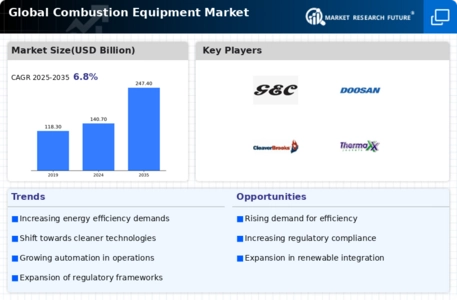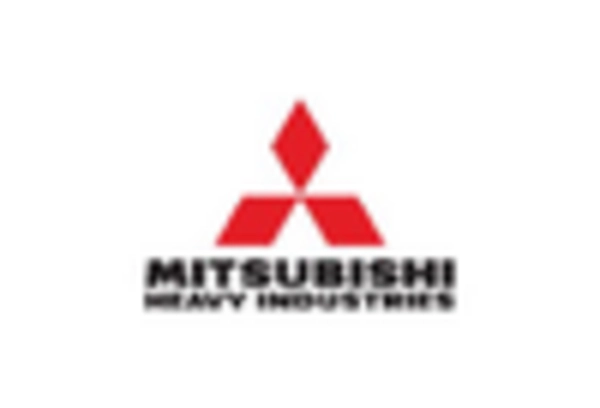Increasing Energy Demand
The rising energy demand across various sectors is a primary driver for the Combustion Equipment Market. As populations grow and industrial activities expand, the need for efficient energy solutions intensifies. According to recent data, energy consumption is projected to increase by approximately 25% by 2040. This surge necessitates advanced combustion technologies that can provide reliable and efficient energy sources. Consequently, manufacturers are focusing on developing innovative combustion equipment that meets stringent regulatory standards while enhancing performance. The growing emphasis on energy security further propels investments in combustion technologies, as nations seek to diversify their energy portfolios and reduce dependency on single sources. Thus, the increasing energy demand is likely to sustain the growth trajectory of the Combustion Equipment Market.
Technological Innovations
Technological advancements play a crucial role in shaping the Combustion Equipment Market. Innovations in combustion technology, such as improved burner designs and enhanced control systems, are enabling higher efficiency and lower emissions. The integration of artificial intelligence and machine learning into combustion systems is also gaining traction, allowing for real-time monitoring and optimization of combustion processes. This not only enhances performance but also reduces operational costs. Furthermore, the development of hybrid systems that combine traditional combustion with renewable energy sources is emerging as a viable solution to meet energy demands sustainably. As these technologies evolve, they are likely to attract investments and drive growth within the Combustion Equipment Market.
Shift Towards Renewable Energy Sources
The transition towards renewable energy sources is influencing the Combustion Equipment Market significantly. As countries strive to meet their climate goals, there is a growing emphasis on integrating renewable energy into existing combustion systems. This shift is prompting manufacturers to develop hybrid combustion technologies that can utilize both traditional fuels and renewable sources, such as biomass and biogas. The market for combustion equipment that supports this transition is expected to expand, as industries seek to reduce their carbon footprint while maintaining energy efficiency. Additionally, the increasing availability of government incentives for renewable energy projects is likely to further stimulate investments in advanced combustion technologies. Thus, the shift towards renewable energy sources is poised to reshape the dynamics of the Combustion Equipment Market.
Rising Industrialization and Urbanization
The ongoing industrialization and urbanization trends are driving the demand for combustion equipment across various sectors. As urban areas expand and industries proliferate, the need for reliable energy sources becomes paramount. The construction, manufacturing, and transportation sectors are particularly reliant on combustion technologies for their energy needs. Data indicates that urban populations are expected to increase by over 60% by 2050, leading to heightened energy consumption. This trend necessitates the development of efficient combustion systems that can cater to the growing energy demands of urban centers. Consequently, the rising industrialization and urbanization are likely to propel the growth of the Combustion Equipment Market, as stakeholders seek innovative solutions to meet the challenges posed by these demographic shifts.
Regulatory Compliance and Environmental Standards
Stringent environmental regulations are shaping the landscape of the Combustion Equipment Market. Governments worldwide are implementing policies aimed at reducing emissions and promoting cleaner technologies. For instance, regulations such as the Clean Air Act in the United States have led to the adoption of advanced combustion systems that minimize pollutants. The market is witnessing a shift towards equipment that complies with these regulations, which often requires significant investment in research and development. As a result, manufacturers are innovating to create combustion equipment that not only meets compliance standards but also enhances operational efficiency. The increasing focus on sustainability and environmental responsibility is expected to drive the demand for advanced combustion technologies, thereby influencing the growth of the Combustion Equipment Market.


















Leave a Comment